Itraconazole is a well-known antifungal medication often prescribed for cats battling various fungal infections. This oral medication is particularly effective against conditions like ringworm and certain systemic mycoses, making it a vital tool for pet owners.
Understanding how itraconazole works and the types of infections it targets can help you keep your feline friend healthy and comfortable.
Administering itraconazole requires attention to dosage and monitoring for potential side effects, which can include liver and kidney strain.
Knowledge of these factors can empower you to manage your cat’s health effectively while using this treatment.
By exploring practical tips and common concerns surrounding itraconazole, you’ll ensure that your pet receives the best care possible.
Key Takeaways
- Itraconazole is effective for treating common fungal infections in cats.
- Proper monitoring is essential to minimize side effects during treatment.
- Understanding alternative options and concerns can enhance your pet care strategy.
Overview of Itraconazole
Itraconazole is a widely used antifungal medication that plays a vital role in treating fungal infections in cats.
It’s important to know how it works and why it’s effective.
What Is Itraconazole?
Itraconazole is an antifungal agent belonging to the class of triazoles.
You may know it by its brand names, such as Itrafungol and Sporanox.
The FDA has approved itraconazole for various uses, including the treatment of Microsporum canis, a common cause of ringworm in cats.
It is available in oral formulations, making it relatively easy to administer.
Your veterinarian may prescribe it based on specific fungal infections or conditions your cat may have.
It’s essential to follow the prescribed dosage closely to maximize effectiveness while minimizing potential side effects.
Itraconazole as an Antifungal Agent
As an antifungal agent, itraconazole works by inhibiting the synthesis of ergosterol, a crucial component of fungal cell membranes.
This action disrupts the membranes, leading to the death of the fungal cells.
Itraconazole is effective against a range of fungal infections, including dermatophytosis and systemic mycoses.
Its versatility is one reason many veterinarians recommend it.
Commonly, itraconazole is dosed at 5 mg/kg for cats, administered once daily for a certain cycle.
Regular follow-ups are essential during treatment to monitor your cat’s response and adjust dosages if necessary.
Remember, maintaining an open line of communication with your veterinarian can make a significant difference in your cat’s recovery process.
Itraconazole and Cats
Itraconazole is a valuable antifungal medication used in treating various fungal infections in cats.
While it’s effective, understanding its safety and efficacy helps you make informed decisions regarding your cat’s health.
Safety Information for Cats
When considering itraconazole for your cat, it’s crucial to know about its safety profile.
Always consult your veterinarian before administering this medication.
Common side effects include gastrointestinal issues such as:
- Decreased appetite
- Vomiting
- Diarrhea
- Increased drooling
- Weight loss
These effects can be dose-dependent, meaning higher doses may lead to more severe symptoms.
Special care should be taken for pregnant or lactating cats, as the effects on kittens in utero or during nursing are not fully understood.
Regular veterinary monitoring is essential, especially if your cat has existing liver issues, as itraconazole may pose additional risks.
Efficacy in Treating Feline Conditions
Itraconazole targets various fungal infections affecting cats, including:
- Ringworm
- Blastomycosis
- Dermatophytosis
- Malassezia
- Sporotrichosis
This systemic antifungal works by inhibiting fungal cell membrane synthesis, helping alleviate symptoms and restore health.
It has shown effectiveness in treating infections not only in the skin but also in respiratory and urinary systems.
Your veterinarian may recommend itraconazole in specific pulse therapies for more severe cases.
This regimen maximizes treatment while minimizing side effects.
By understanding both the safety and efficacy of itraconazole, you can ensure that your feline friend receives the best possible care during treatment.
Common Fungal Infections in Cats
Fungal infections in cats can range from superficial skin issues to serious systemic conditions.
Understanding the most common types helps you identify symptoms and seek prompt treatment.
Ringworm and Dermatophytosis
Ringworm, caused primarily by the dermatophyte Microsporum canis, is a contagious fungal infection affecting your cat’s skin, fur, and nails.
You might notice patchy hair loss, flaky skin, or redness.
It’s often found in young or immunocompromised cats due to their susceptibility.
Treatment typically involves antifungal medications such as itraconazole, as well as topical therapies to help eliminate the infection.
Regular cleaning of your cat’s environment, including bedding and grooming tools, can reduce the risk of re-infection.
Remember, ringworm can spread to humans, so practicing good hygiene during treatment is essential.
Cryptococcosis and Other Yeast Infections
Cryptococcosis is a serious fungal infection caused by the yeast Cryptococcus neoformans.
It can lead to respiratory problems and neurologic issues, affecting both cats and dogs.
Common symptoms include nasal discharge, coughing, and lack of appetite.
Other yeast infections, such as those caused by Malassezia, often occur in areas with excess moisture.
Treatment typically involves antifungal medications and sometimes topical treatments.
Early detection is crucial, as these infections can become more severe if left untreated.
Systemic Fungal Infections
Systemic fungal infections can affect your cat’s internal organs and require urgent medical attention.
Conditions like blastomycosis and histoplasmosis are transmitted through spores in the environment.
Symptoms may include fever, weight loss, and lethargy.
Coccidioidomycosis, or Valley Fever, is another systemic infection related to dust and soil disturbances.
These infections require comprehensive treatment protocols often involving itraconazole.
If you notice persistent symptoms in your cat, prompt veterinary assessment is key to effective care and recovery.
Administering Itraconazole
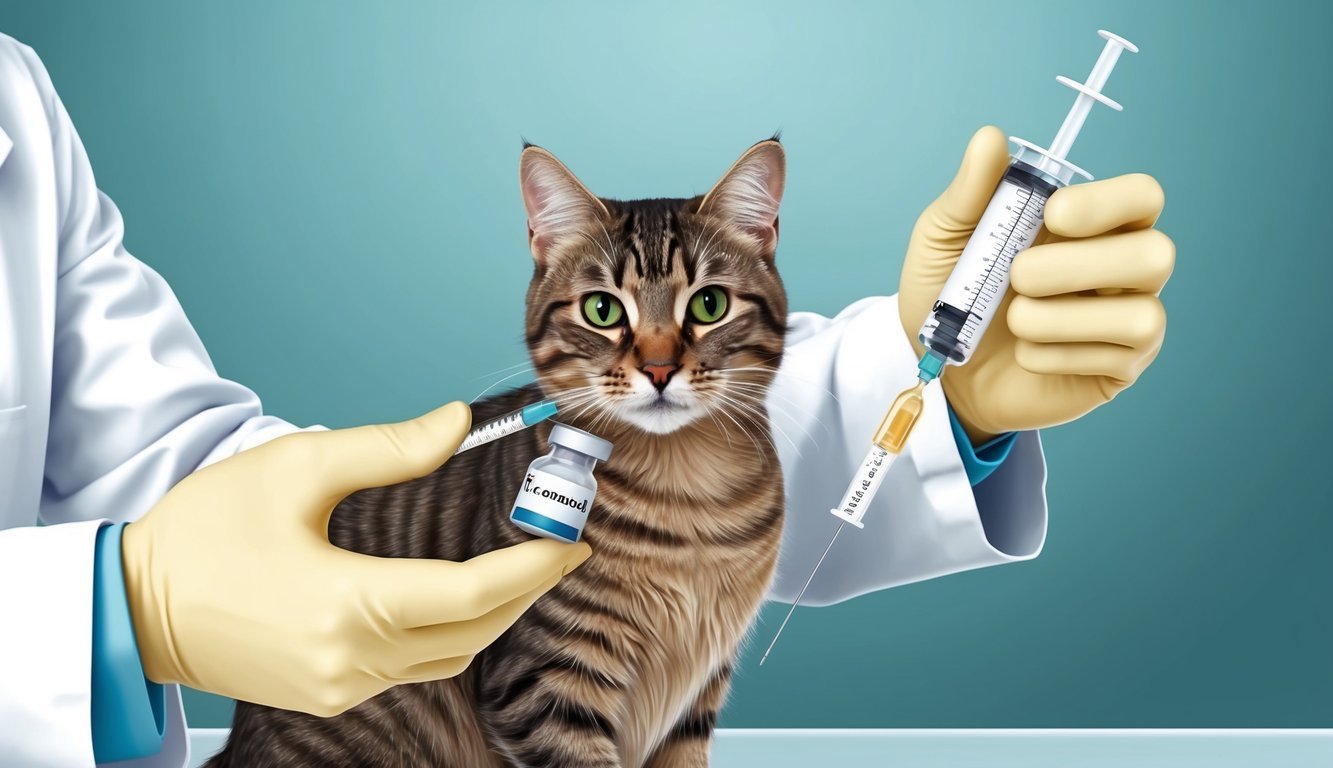
Administering itraconazole involves understanding the correct dosage, the differences between oral forms, and how to read prescription labels effectively.
It’s essential to follow these guidelines closely to ensure your cat receives the proper treatment without unnecessary complications.
Dosage and Dosing Frequency
The dosage of itraconazole for your cat typically depends on the specific fungal infection being treated.
Your veterinarian will determine the appropriate dose, which is generally around 5 mg/kg daily, but it may vary based on your cat’s condition and size.
Most treatment regimens last from 1 to 4 months, emphasizing the importance of adhering to the prescribed schedule.
It’s crucial to avoid skipping doses or discontinuing the treatment early, as this can lead to treatment failure.
If you miss a dose, give it as soon as you remember.
If it’s almost time for the next dose, skip the missed one and resume your regular schedule.
Always use a dosing syringe for accuracy, especially if using an oral solution.
Oral Solution vs. Capsules
Itraconazole is available in both oral solution and capsule forms.
Each has its benefits, and the choice often depends on your cat’s specific needs.
The oral solution is easier to administer since it can be measured precisely with a dosing syringe.
It’s particularly beneficial for cats that are difficult to medicate or refuse pills.
On the other hand, capsules may offer convenience for cats that accept them without issue.
Some cats may prefer one over the other, so monitor your pet’s response and consult your veterinarian if you face challenges.
Understanding Prescription Labels
When you receive your cat’s itraconazole prescription, take a moment to familiarize yourself with the label.
It contains vital information such as the drug’s name, dosage, and administration instructions.
Look for key information:
- Patient Name: Ensure it’s your cat’s name.
- Dosage Instructions: Follow the specified dose closely.
- Number of Refills: Know how many times you can refill the prescription.
If you have questions about the label or how to administer itraconazole, don’t hesitate to ask your veterinarian for clarification.
It’s essential to understand your cat’s treatment fully to ensure their health and well-being.
Monitoring and Side Effects

When your cat is prescribed itraconazole, it’s crucial to monitor for side effects and ensure their liver remains healthy.
Being aware of potential adverse reactions can help you take prompt action if needed.
Here’s what you should look out for.
Recognizing Adverse Reactions
Itraconazole can cause several side effects in cats.
Watch for signs like:
- Decreased Appetite: A significant drop in how much your cat eats.
- Vomiting: Occasional vomiting may occur; however, persistent vomiting requires veterinary attention.
- Diarrhea: This can range from mild to severe. If it lasts more than a day or two, consult your vet.
- Increased Drooling: An unusual amount of drooling may indicate discomfort.
- Weight Loss: Keep an eye on your cat’s weight, as sudden changes might signal an issue.
Monitoring these symptoms closely allows you to react quickly to any potential problems.
Long-Term Side Effects
While many cats tolerate itraconazole well, some may experience long-term effects.
Prolonged use can lead to liver dysfunction, so regular check-ups are essential.
Symptoms of liver issues include:
- Jaundice: Yellowing of the skin or eyes, indicating liver problems.
- Liver Toxicity: This can manifest as lethargy, increased thirst, or excessive urination.
Be vigilant about any changes in your cat’s behavior or health over time.
Regular communication with your vet can help manage any risks associated with long-term itraconazole use.
Addressing Resistance and Alternatives
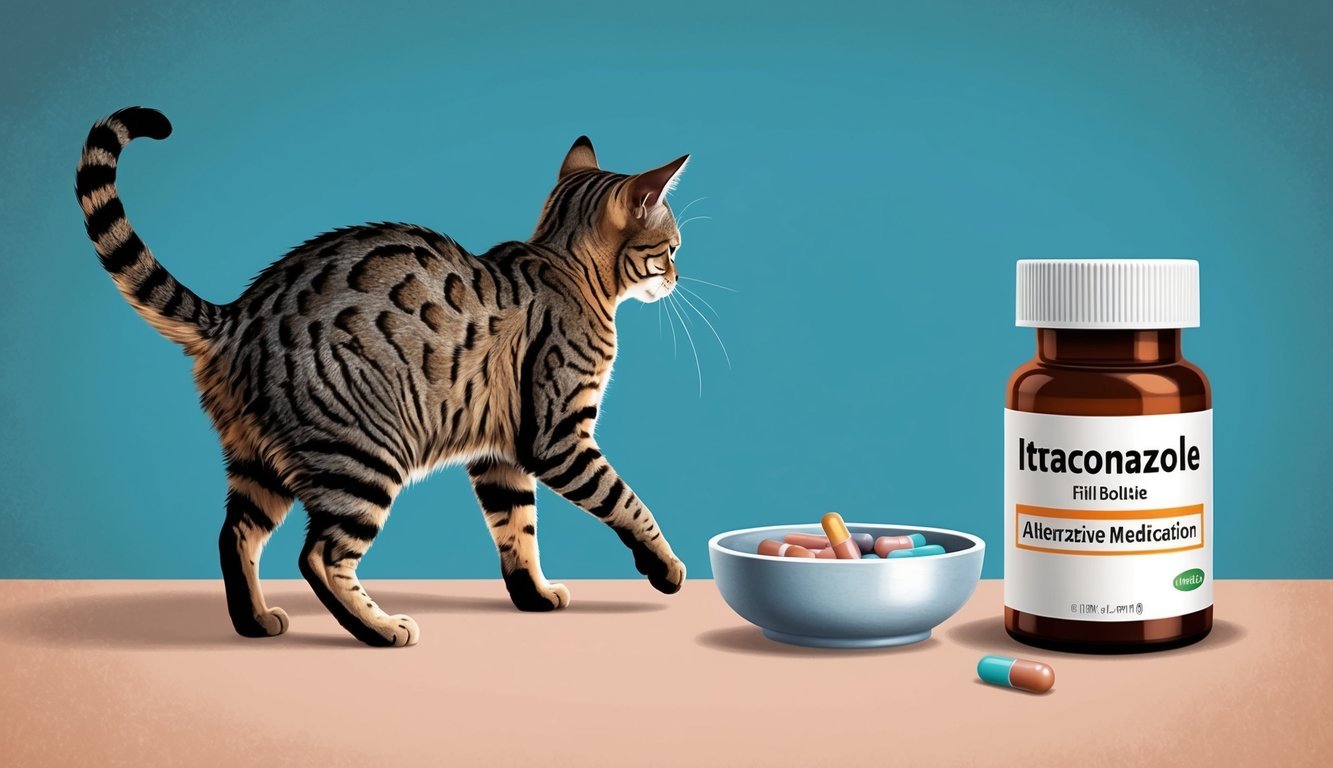
Understanding antifungal resistance and exploring alternative treatments is essential when using itraconazole in cats.
Your knowledge of these aspects can lead to better outcomes for your feline companions.
Potential for Antifungal Resistance
Antifungal resistance is a real concern with veterinary treatments.
Itraconazole is generally effective, but certain fungi can develop resistance.
With fluconazole, for instance, both inherent and acquired resistance have been documented.
This means some fungal infections may persist despite treatment.
Careful monitoring is vital; if you notice your cat not responding to itraconazole, consult your veterinarian.
They may recommend testing or a change in medication.
In some cases, cross-resistance can occur with other antifungal drugs like ketoconazole or miconazole.
Therefore, understanding your cat’s specific infection can lead to a targeted approach.
Alternative Antifungal Treatments
If itraconazole proves ineffective, you can try other antifungal treatments. Fluconazole is an option, particularly for urinary tract infections, as it is mainly excreted unchanged in the urine.
Amphotericin B is another potent antifungal.
It’s usually reserved for severe infections due to its potential side effects.
Like itraconazole, it works well against more resistant organisms.
Miconazole, available in topical forms, can help treat surface fungal infections effectively.
You may also consider combining medications under a veterinarian’s guidance.
This can enhance efficacy while mitigating the potential for resistance.
Special Considerations
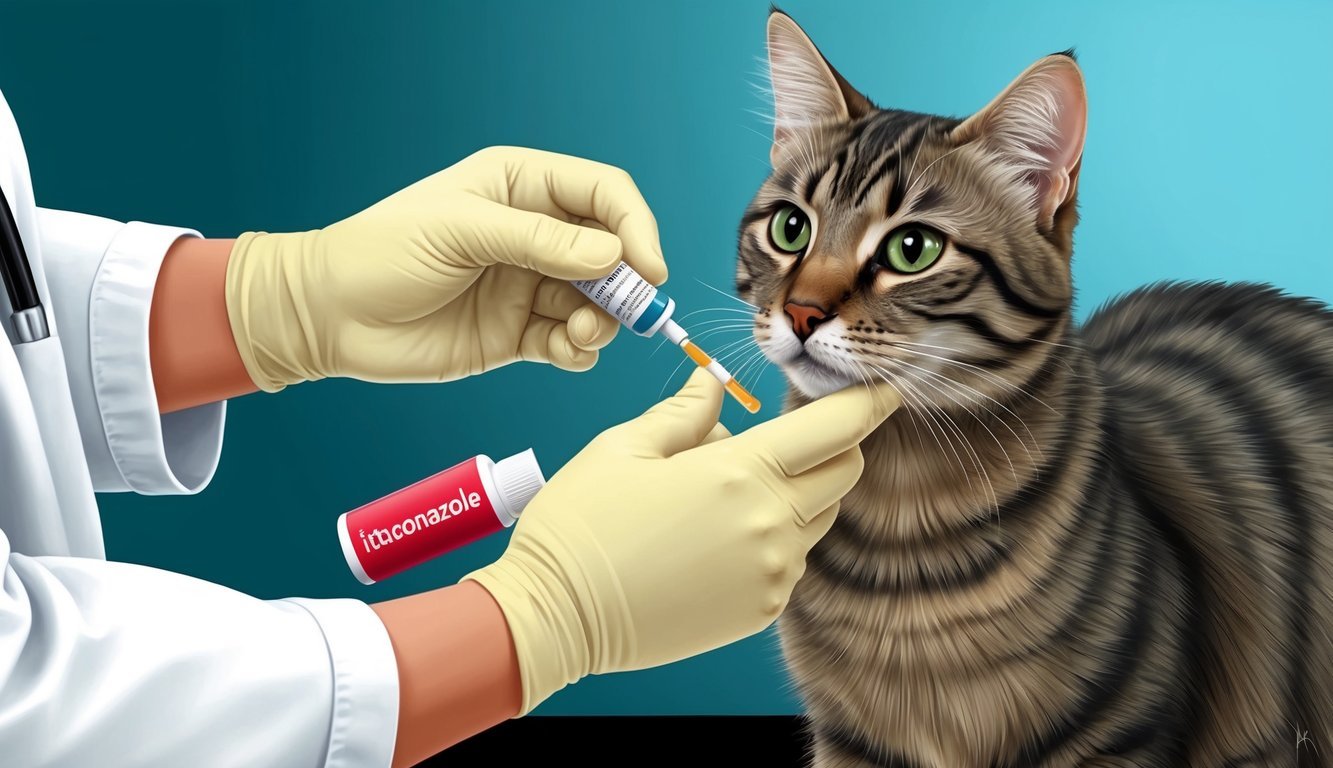
When considering itraconazole for your cat, it’s essential to be aware of specific contraindications and guidelines for use in particular populations.
This information helps ensure the safe and effective treatment of fungal infections.
Contraindications and Cautions
Before administering itraconazole, check for hypersensitivity to the drug.
If your cat has had previous adverse reactions, it’s best to avoid this medication.
Renal dysfunction is another critical factor.
Itraconazole is metabolized in the liver and excreted by the kidneys, so impaired kidney function can lead to complications.
Monitor your cat closely if they have any kidney issues.
In addition, consider the potential zoonotic risks if your cat is in close contact with immunocompromised individuals or other pets.
Discuss with your veterinarian about the best course of action if you have concerns regarding your environment.
Use in Specific Populations
When it comes to certain populations, pregnant and lactating cats require special attention.
Itraconazole’s safety in these groups isn’t well established, so it’s important to weigh the risks and benefits with your vet.
For kittens, the use of itraconazole can be tricky.
Their developing systems might not handle the medication well, leading to unexpected side effects.
Consult your veterinarian for guidance on dosage and suitability.
Always keep an eye on any adverse effects, especially gastrointestinal issues like vomiting or diarrhea.
Regular check-ups during treatment can help mitigate risks.
Diagnosis and Clinical Management
When treating fungal infections in cats, accurate diagnosis and effective management are critical.
Identifying clinical signs early can lead to better outcomes, while tracking improvement is essential for determining treatment success.
Clinical Signs and Diagnosis
You might notice several clinical signs in your cat, indicating a possible fungal infection.
Common symptoms include hair loss, alopecia, and erythema on the skin.
Lesions often appear as circular patches with scaly borders.
These signs can cause distress and discomfort for your pet.
Diagnosis typically involves several methods.
A Wood’s ultraviolet lamp may be used to visualize the infection.
Additionally, mycological cultures and skin scrapings help confirm the presence of fungi.
Your veterinarian may combine these diagnostic tools to ensure an accurate diagnosis.
Tracking Clinical Improvement
Monitoring your cat’s response to itraconazole treatment is essential for assessing clinical improvement.
Regular check-ups will help your vet evaluate whether the treatment is effective.
Look for signs such as reduced lesions, improved fur texture, and overall behavior change.
You can also keep a journal documenting observed changes in your cat.
Record details such as the appearance of skin lesions, any new signs, or variations in appetite.
This information can provide your veterinarian with valuable insights to adjust the treatment if necessary.
Practical Tips for Pet Owners
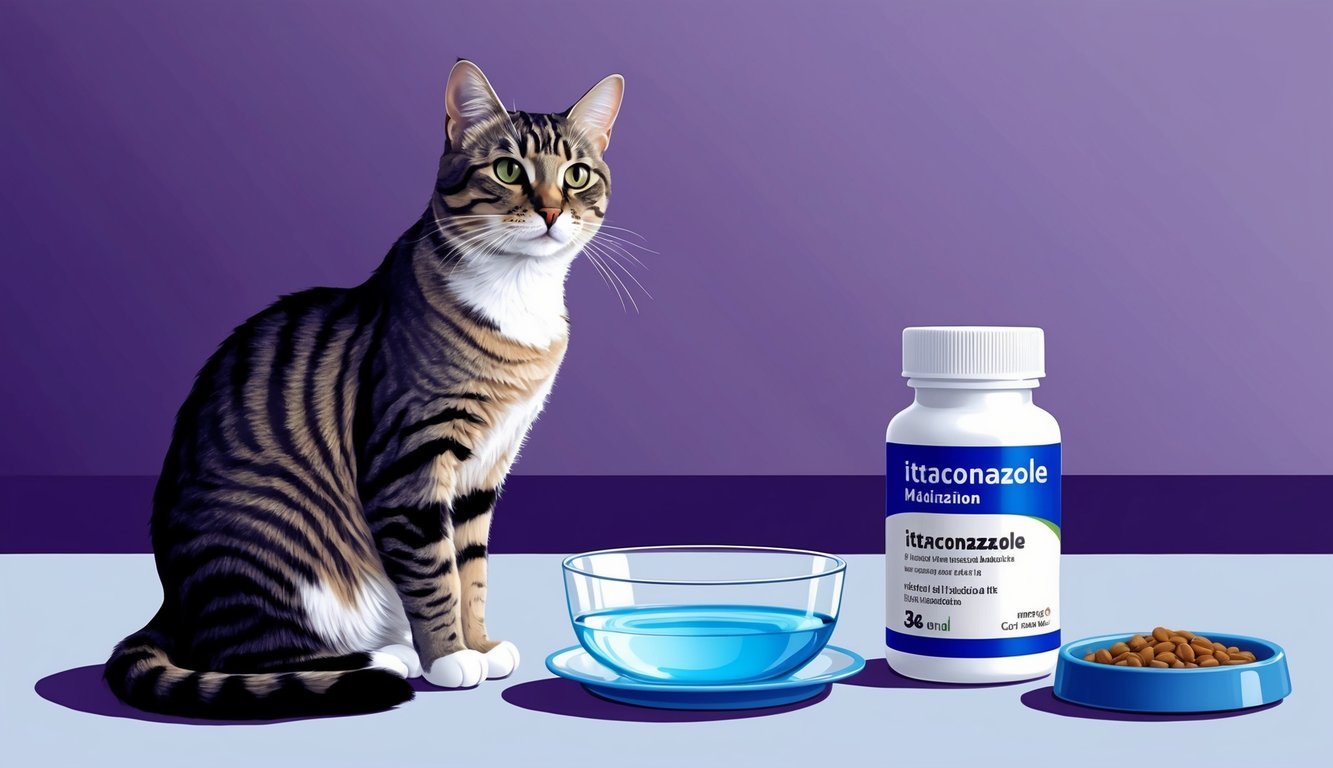
When your cat is prescribed itraconazole, knowing how to effectively administer the medication and monitor your cat is essential.
Here are some practical tips to help you navigate this process.
Administering Medication at Home
Giving your cat medication can be challenging, but with the right approach, it can be manageable.
Always follow your veterinarian’s dosage instructions.
If using Itrafungol, you can administer it with or without food.
To make the process easier, try these strategies:
- Pill Pockets: Use treats designed to conceal pills.
- Syringe Medication: If using a liquid form, a syringe can help deliver the dose directly into your cat’s mouth.
- Calm Environment: Make sure your cat is in a calm space to reduce stress during administration.
Be patient, as it may take time for your cat to adjust to taking medication.
Observing and Reporting Side Effects
Monitoring your cat for side effects is crucial when administering itraconazole.
Common side effects may include vomiting, diarrhea, or lethargy.
Stay vigilant and take note of:
- Changes in appetite
- Behavioral shifts or increased irritation
- Signs of skin irritation or rash
It’s important to report any unusual behaviors or severe side effects to your veterinarian immediately.
They may need to adjust the treatment plan or offer solutions to manage adverse reactions effectively.
Maintaining Proper Storage
Proper storage of itraconazole is vital to ensure its effectiveness.
Keep your medication in a cool, dry place away from direct sunlight.
Follow these storage tips:
- Original Packaging: Always keep the medication in its original container, clearly labeled with your cat’s name and the dosage.
- Child-proof Locations: Ensure the medication is stored in a location that is out of reach of children and pets.
- Expiration Dates: Regularly check expiration dates and dispose of any expired medication responsibly.
By maintaining proper storage, you can help ensure that itraconazole remains effective for your cat’s treatment.
Frequently Asked Questions
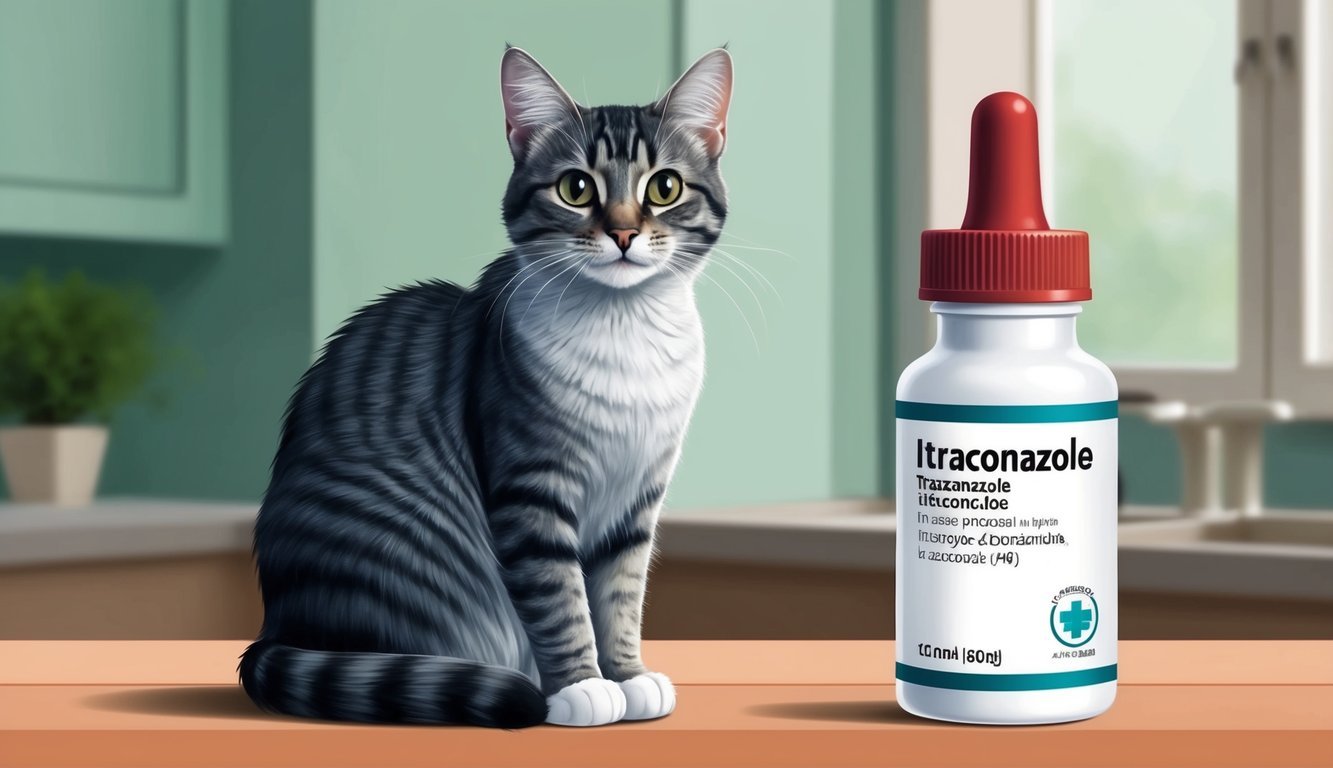
Here are some common queries about itraconazole and its use in treating fungal infections in cats.
Understanding these points can help you make informed decisions regarding your pet’s treatment.
How should itraconazole be administered to cats?
Itraconazole can be given orally in the form of a capsule or a liquid solution.
When administering it, ensure your cat swallows it completely.
If you’re using a liquid formulation, measuring the dose accurately with a syringe is essential for proper dosing.
What is the standard dosage of itraconazole for treating ringworm in cats?
The typical dosage for treating ringworm is about 5 mg per kilogram of body weight.
This is usually given once daily.
Always follow your veterinarian’s specific instructions regarding dosing to ensure the best results.
Can itraconazole cause any adverse effects in felines?
Yes, itraconazole may cause side effects, including vomiting, diarrhea, and loss of appetite.
Some cats may also experience increased liver enzymes.
It’s important to monitor your cat during treatment and report any concerns to your veterinarian.
How long does it typically take for itraconazole to show results in cats with ringworm?
You may start to see improvements in about 2 to 4 weeks after starting treatment.
The timeline can vary based on the severity of the infection and how well your cat responds to the medication.
Regular veterinary check-ups are important to track progress.
Are there any specific considerations when giving itraconazole to cats?
It’s crucial to assess your cat’s overall health before starting treatment.
If your cat has liver issues or is pregnant, itraconazole may not be the best option.
Always discuss your cat’s health history with your veterinarian for tailored advice.
What should a pet owner know before purchasing itraconazole for their cat?
Before buying itraconazole, make sure you have a veterinarian’s prescription and guidance.
Your vet can recommend the most appropriate formulation for your cat’s specific condition.
Different formulations may be available.
Be cautious with dosages and always follow the vet’s instructions.

